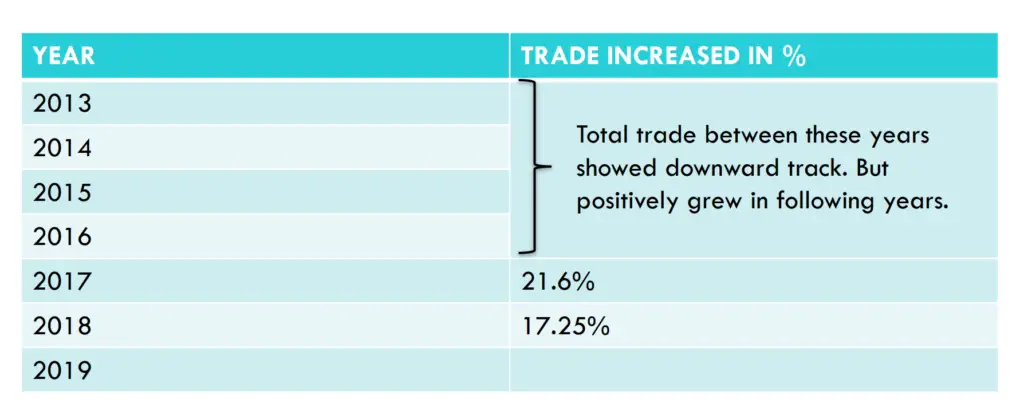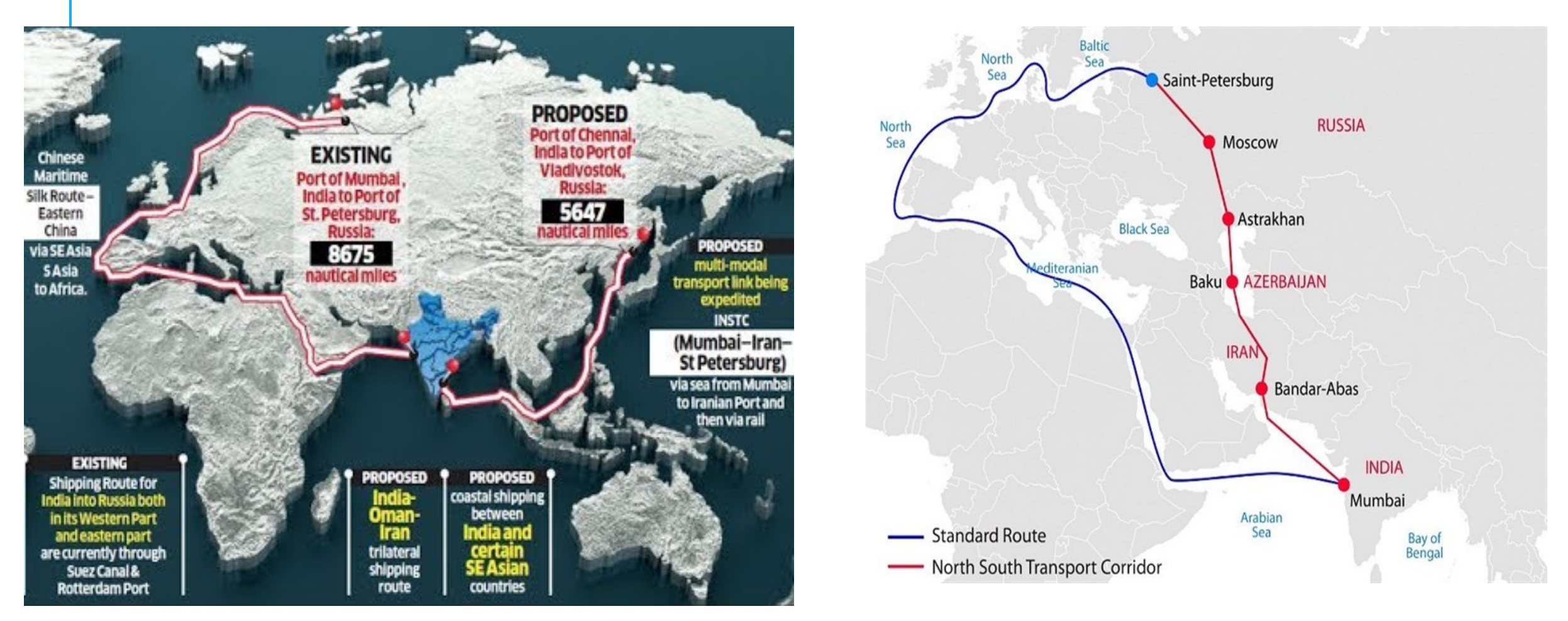INDIA-RUSSIA Relations
“Russia is a Pacific Power which has Indian Ocean interests” while “India is an Indian Ocean power with very strong and growing Pacific interest”
The relationship between the two nations has evolved significantly, marked by a notable transformation in various key areas of cooperation:
- Political Relations: There has been a substantial strengthening of political ties, fostering a deeper sense of collaboration and mutual understanding.
- Security Domain: Both countries have intensified their engagement in matters related to security, reflecting a shared commitment to safeguarding their interests.
- Defense Sector: Significant advancements have been made in defense cooperation, enhancing the defense capabilities of both nations.
- Trade & Economy: Bilateral trade and economic relations have flourished, contributing to economic growth and prosperity for both sides.
- Science & Technology Advancements + Nuclear Cooperation: Collaborations in science, technology, and nuclear initiatives have seen remarkable progress, signifying a commitment to scientific innovation and responsible nuclear cooperation.
- Cultural Aspects: Cultural exchanges and interactions have deepened, promoting cross-cultural understanding and appreciation.
This qualitative shift in the relationship underscores the multi-faceted nature of their cooperation, reflecting a commitment to mutual growth and progress.
POLITICAL RELATIONS
India and Russia share a deep-rooted history of cooperation, founded on trust and mutual benefit. Following the dissolution of the Soviet Union, both nations embarked on a new era of collaboration, marked by the signing of a Treaty of Friendship and Cooperation in January 1993 and a bilateral Military-Technical Cooperation agreement in 1994. Several tools and mechanisms contribute to the strength of their political relations:
- Annual Summits: These summits serve as a vital platform for fostering trust and achieving common objectives. They provide an opportunity for both nations to strengthen their bonds and exchange perspectives on global and regional issues.
- Intergovernmental Commissions: Regular high-level interactions through these commissions play a crucial role in building robust relations. Two key commissions have been established, focusing on areas such as trade, economics, science, technology, culture, and military technology cooperation.
- Bilateral Interactions: These interactions facilitate a deeper mutual understanding and offer a well-informed foundation for future policy dialogues between the two nations.
- Consultations: Consultations aid in problem-solving and goal accomplishment. Various issues have found resolution through constructive consultations, demonstrating the effectiveness of this mechanism.
Through these diverse tools of political engagement, India and Russia continue to fortify their relationship, ensuring a stable and productive partnership.
DEFENSE & SECURITY COOPERATION
India and Russia share a longstanding and comprehensive collaboration in the realm of defense. This relationship has transitioned from a simple buyer-seller dynamic to a partnership involving joint research and development, as well as the production of cutting-edge defense technologies and systems. Notable examples include the enhancement of the range of the BrahMos Missile System, the development of SU-30 aircraft, and the production of T-90 tanks.
Furthermore, the tri-exercise named INDIRA has played a pivotal role in strengthening skills related to field operations, marine activities, and flight operations, bolstering the defense cooperation between the two nations.
Another significant contribution to this collaboration is the Military Industry Conference, which has actively facilitated both public and private sector participation. This engagement underscores the commitment of India and Russia to advancing their defense and security cooperation to address contemporary challenges effectively.
TRADE & ECONOMIC RELATIONS
Trade and economic relations between India and Russia have been accorded priority status by both nations. This commitment is evident in their revised targets, which aim to increase bilateral investments and trade volumes to $50 billion and $30 billion, respectively, by the year 2025.
Russia’s external trade has faced challenges, including a prolonged dispute with Western countries over the Ukraine issue and a general economic slowdown triggered by the COVID-19 pandemic. India’s willingness to collaborate with Russia will contribute significantly to strengthening trade ties between the two nations. This cooperation reflects the mutual intent to deepen economic engagement and foster prosperity for both India and Russia.

MAJOR COMPONENTS OF TRADE BETWEEN INDIA-RUSSIA
| IMPORT FROM RUSSIA | EXPORT TO RUSSIA |
|---|---|
| 1. Mineral fuels, mineral oils & mineral waxes. | 1. Pharmaceutical products. |
| 2. Precious & Semi-Precious Stones | 2. Electrical machinery & appliances. |
| 3. Nuclear reactors, boilers, machinery & appliances. | 3. Nuclear reactors, boilers, machineries & accessories. |
| 4. Electrical machineries & their parts. | 4. Organic Chemicals. |
| 5. Fertilizers. | 5. Vehicles except railways. |
SECTOR SPECIFIC INVESTMENTS
| (India’s Focus) | (Russia’s Focus) |
|---|---|
| 1. Transport Infrastructure | 1. Banking |
| 2. Agriculture & Agro-processing sectors | 2. Finance |
| 3. Small & Medium Business | 3. Industry |
| 4. Digital transformation | 4. Tourism |
| 5. Industrial Trade Cooperation | 5. Connectivity |
| 6. Hydrocarbons (Potentially Emphasized by India) | 6. Trade |
To facilitate engagement in the aforementioned sectors, Russia has introduced a “Single Window Service,” which offers a streamlined and hassle-free mechanism to achieve their mutual trade and investment objectives. Additionally, several other projects have been initiated to boost the flow of trade, including:
- Green Corridor
- International North South Transport Corridor
- Free Trade Agreement with the Eurasian Economic Union
Collaboration in Science & Technology
Space, and Nuclear Energy between India and Russia has a storied history, dating back to the signing of the Science & Technology Agreement in 1972. In order to bolster their relationship in the realm of Science & Technology, three significant institutional mechanisms were put in place:
Science & Technology Cooperation Mechanisms:
- Working Groups: These facilitate in-depth discussions and collaboration on various scientific and technological subjects, contributing to a robust partnership in research and innovation.
- Integrated Long-Term Programme (ILTP): ILTP focuses on fostering cooperation in long-term scientific and technological projects, enabling both nations to work together on ambitious endeavors.
- Basic Science Cooperation Programme: This initiative promotes joint efforts in fundamental scientific research, ensuring a strong foundation for scientific cooperation.
Recently, the Department of Science & Technology launched the India-Russia joint Technology Assessment & Accelerated Commercialization Programme, which is designed to boost collaborative research and development activities, particularly in small and medium enterprises as well as startups.
In the domain of space exploration, both countries collaborate on various peaceful uses of outer space, encompassing:
Outer Space Cooperation:
- Satellite Launches: Joint efforts in launching satellites for various purposes, including communication and earth observation.
- GLONASS Navigation System: Cooperation in satellite navigation systems, enhancing global positioning capabilities.
- Remote Sensing Applications: Sharing expertise and technology in remote sensing for applications such as environmental monitoring and disaster management.
Additionally, ISRO (Indian Space Research Organisation) and ROSCOSMOS have recently entered into collaboration within the field of Human Spaceflight through the GAGANYAAN Human Spaceflight Programme.
Space Technology Domains under Consideration:
- Production of Space Systems in India: Exploring possibilities for manufacturing space systems within India, fostering self-reliance.
- Rocket Systems: Collaborative development and advancement of rocket systems for space missions.
- Propellants & Propulsion Systems: Joint efforts in propellant and propulsion technology for space exploration.
- Spacecraft & Launch Vehicles: Collaborative projects related to spacecraft and launch vehicles for future missions.
In the sphere of nuclear energy, India is recognized as a significant partner by Russia, acknowledging India’s advanced nuclear technology capabilities and its impeccable non-proliferation record. The construction of the KUNDANKULAM NUCLEAR POWER PLANT is a prominent example of Russian-Indian cooperation in this field. Additionally, a trilateral agreement involving India, Russia, and Bangladesh has been signed for the implementation of the ROOPPUR NUCLEAR POWER PLANT construction in Bangladesh, further solidifying the collaboration in the nuclear energy sector.
INTERNATIONAL NORTH SOUTH TRANSPORT CORRIDOR

The INSTC, or International North-South Transport Corridor, is driven by two primary objectives:
- Enhancing Trade Connectivity: The first objective is to bolster trade connectivity among major cities within the region. This entails establishing efficient transport routes that facilitate the movement of goods and resources between these key urban centers.
- Resolving Trade Bottlenecks: The second objective involves identifying and resolving critical bottlenecks and challenges that arise when trade passes through various regions. The aim is to streamline the trade process and ensure smoother and more efficient trade flow.
Green Corridor
The ‘Green Corridor’ initiative aims to facilitate the seamless movement of goods in order to boost bilateral trade, which has not fully realized its potential despite the robust political relations between the nations involved. One key advantage of the ‘Green Corridor’ is that it eliminates the need for customs inspections and examinations when goods cross international borders. This streamlines the trade process and promotes efficiency.
Global Domain
Russia has become a significant focal point in our transition from a coal-based economy to a gas-based one. For instance, the maritime route connecting Vladivostok in Far East Russia to Chennai holds immense potential for India’s future growth.
Approximately 67% of India’s military hardware originates from Russia, and the repair and maintenance of these assets will necessitate Russia’s involvement. Key assets like nuclear submarines, artillery guns, and air defense systems are crucial for our national security. Despite the threat of US CAATSA sanctions, we chose to acquire the S-400 air defense system from Russia because of its technological superiority over the US Patriot Missile system.
Russia’s agreement to transfer technology aligns with India’s “Make in India” program and reflects the competitiveness of the global market. In today’s world, we must engage with all countries, and the USA is a vital economic partner, which Russia is not.
Currently, economic relations between India and Russia are limited to $10 billion, highlighting the need to explore new trade avenues for stronger economic ties. De-dollarization on a global scale could facilitate stronger bilateral relations between countries, as exemplified by India-Iran deals conducted through currency exchange to bypass US sanctions.
During the Soviet era, trade between India and Russia was conducted in Rupees and Rubles. However, some strategic projects may necessitate dealing in US Dollars, given the prevailing dominance of the Dollar during times of financial crises.
Challenges and Concerns:
- Demographic Decline: Russia’s shrinking population and the influence of oligarchs pose challenges for external businesses trying to enter the Russian market. State privileges often favor Russian businessmen, making the market semi-permeable. To navigate this, India must focus on specific growth areas, such as gas extraction in Far East Russia.
- China’s Influence: The dynamics between Russia, China, and the United States have shifted. While previously competitors, Russia and China are now partnering to counter US influence in global markets. Russia has committed to providing next-generation aircraft to China due to strategic considerations, like the Bering Sea.
- Pakistan Connection: Russia’s recent treaty on Naval Cooperation with Pakistan has raised concerns in India. It signals that Russia may consider other options for selling its manufactured products. Additionally, Russia’s support for Pakistan’s stance on Afghanistan and the Taliban peace talks contradicts India’s position.
The Way Forward
- Prioritize Needs: India should assess its requirements in terms of technology, energy, and military hardware and procure them from available sources, whether it’s Rafael from France, Apache and Chinook from the USA, or other options that align with its needs.
- Navigate Diplomacy: While finding areas of convergence with Russia is important, especially on specific issues, it’s equally crucial to differentiate between convergences and divergences, especially when dealing with power dynamics.
- Adaptability in Foreign Policy: Recognize that nothing in international relations is permanent. Relationships should be adaptable based on circumstances, with the primary focus on safeguarding national interests without being seen as selfish.
- Issue-Based Foreign Policy: Craft foreign policy that is centered around specific issues and objectives, ensuring a clear and strategic approach.
- Include Afghanistan: Consider strategic cooperation in third-world countries, particularly Afghanistan, due to shared history and interests. Stabilizing key countries in the region is vital, especially in light of the presence of ISIS in Tajikistan. Russia’s substantial interest in resolving Afghanistan’s instability aligns with India’s goals, as it can help make the INSTC more accessible and hurdle-free, providing India with access to Middle East markets through bottleneck areas with fewer challenges.
